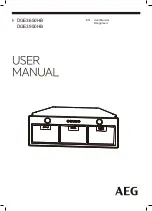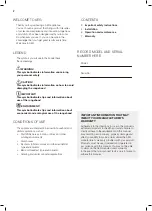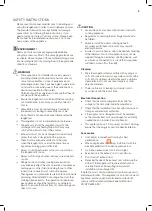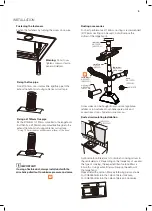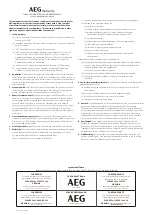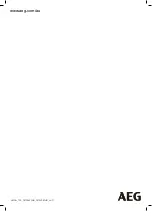
3
SAFETY INSTRUCTIONS
Please read this manual carefully prior to installing and
using the rangehood in order to avoid damage or injury.
The manufacturer will not accept liability for damage
caused from not following these instructions. If you
need assistance contact Customer Care. Please keep
the manual for future reference and pass it on to any
new owners of the appliance.
ENVIRONMENT!
Remove and discard any packaging material before
using this accessory. Most of the packaging materials are
recyclable. Please dispose of those materials through your
local recycling depot or by placing them in the appropriate
collection containers.
WARNING!
This appliance is not intended for use by persons
(including children) with reduced physical, sensory
or mental capabilities, or lack of experience and
knowledge, unless they have been given supervision
or instruction concerning use of the appliance by a
person responsible for their safety.
Children should be supervised to ensure that they do
not play with the appliance.
Ensure the rangehood is switched off before carrying
out maintenance, to avoid any possibility of electric
shock.
Grease filters must be removed every four weeks
(maximum) for cleaning to reduce the risk of fire.
Do not flambe or have an exposed flame under the
rangehood.
This rangehood is not recommended for barbecues.
The exhaust air from the rangehood must not be
discharged into any heating flue, which may carry
combustion products from other sources.
Exhaust air must not be discharged into a wall cavity,
unless the cavity is designed for the purpose.
There must be adequate ventilation of the room
when the rangehood is used at the same time as
appliances burning gas or other fuels.
Always cover lit gas burners with pots or pans when
the rangehood is in use.
Always switch off gas burners before you remove pots
or pans.
CAUTION
Accessible parts may become hot when used with
cooking appliance.
Regulations concerning the discharge of air have to
be fulfilled.
Failure to install the screws or fixing device in
accordance with these instructions may result in
electrical hazards.
Cleaning
Wipe the rangehood body and flue with a sponge or
soft cloth soaked in warm soapy water, and dry with a
soft cloth, for stainless steel models apply a stainless
steel protector. Do not use oven cleaners or other
abrasive materials.
There is a fire risk if cleaning is not carried out in
accordance with the instructions.
Electrical Connection
Check that the mains voltage matches with the
voltage on the data plate inside the rangehood.
Check that the installation complies with standards of
local gas and electricity authorities.
If the supply cord is damaged, it must be replaced
by the manufacturer or its service agent or a similarly
qualified person in order to avoid a hazard.
Accessories
Use 150mm round exhaust ducting for best
performance.
When using flexible duct always install duct with the
wire helix pulled taut to minimise pressure loss.
Try to keep exhaust duct short and straight.
Keep bends in the exhaust duct to a minimum.
Do not restrict exhaust duct.
Reducing the size of the exhaust duct will reduce the
airflow of the rangehood. Please read instructions
carefully. Service calls resulting from incorrect
installation will be charged for.
Installation must comply in all respects with your gas and
electrical authorities. This rangehood is an indoor domestic
appliance, and has been manufactured and tested to
comply with Australian and New Zealand Standard
AS/NZS 60335.2.31
In order to avoid a hazard due to inadvertent resetting
of the thermal cut-out, this appliance must not be
supplied through an external switching device, such
as a timer, or connected to a circuit that is regularly
switched on and off by the utility.
This appliance has a 1.2m power cord and 10A plug,
ensure that the plug is accessible after installation.
Range hoods and other cooking fume extractors
may adversely affect the safe operation of appliances
burning gas or other fuels (including those in other
rooms) due to back flow of combustion gases.
These gases can potentially result in carbon monoxide
poisoning. After installation of a range hood or other
cooking fume extractor, the operation of open flued
gas appliances should be tested by a competent
person to ensure that back flow of combustion gases
does not occur.

